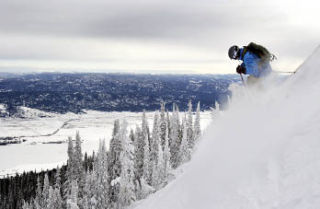While many in our state were recently consumed with watching the rain fall and the rivers flood, I was able to escape for a few days to the mountains of Idaho. Now, when I tell you that, I’ll bet you are thinking my destination was Sun Valley or maybe Schweitzer, but only if you guessed Tamarack and Brundage would you be correct.
I flew to Boise and drove two hours north to Tamarack, not only America’s newest ski resort but also one that was forced into bankruptcy proceedings last year after the wheels came off its financial wagon. I had been here before a couple of times, and when some friends said they were going, I decided to see how the financial implosion was affecting the snow sliding. I am pleased to report that the on-mountain product is as good as ever.
First, some background: originally proposed as a four-season resort way back in the early 1990s, Tamarack finally opened in December 2004 on what was called West Mountain, just down the road from the town of McCall. Locals were used to skiing in the area, as McCall was the location of its long-time resort called Brundage Mountain. For awhile all was good, and as real estate sales took off, Tamarack seemed poised for the big time. But a perfect storm of financial difficulties in 2008 caused the snow globe to burst, and ultimately a receiver was court-appointed to oversee its operations.
Based on what I saw, the resort still has a few things going for it. Number one, the mountain has 2,800 feet of vertical and over 1,100 acres of lift-accessed terrain. As for setting, Tamarack is situated in a prime spot. To the west, the Cascade Mountains and the high desert of eastern Oregon wring much of the excess moisture from Pacific storms, so over 300 inches of dry snow falls on Tamarack’s east-facing, wind-shielded slopes. This is more than its Idaho cousin Sun Valley gets, and those of us from the Cascades will not complain about the quality of snow underfoot.
However, because everything needed to be new, and because they basically ran out of money to do it, not everything planned for the base village is in place yet. The lift system works fine, but many of the facilities are housed in temporary, tent-like structures, though they don’t feel temporary once inside. Guests will find most everything that a skier could want: rental shop, cafeteria, children’s programs, gourmet grocery store — even fine-dining restaurants and an espresso bar. For skinny-skiers, a 20-mile Nordic ski course is set on the adjoining championship golf course; there is also a separate snowshoe track, which I utilized at night before dinner.
Snow sliders with avalanche savvy can leave the resort behind and sample the out-of-bounds possibilities in the national forests that bookend the resort. These pristine slopes can be accessed by a short hike off the top of the mountain or by snowcat. My group was lucky to get space on the snowcat, and we experienced 12 inches of untouched powder three days after a storm.
“This place really skis big — even though it’s a small- to medium-sized ski area,” said Ken Rider, resort marketing guru and one of a crew of ski-industry veterans who were hired to get Tamarack up and running. I was struck by the fact that almost to a person, all the employees specifically chose to come to Tamarack, leaving places such as Deer Valley, Breckenridge and Bend, and even with the current financial morass, they remain optimistic and committed to living there. As backcountry guides John Costa and Dave Williams stated, “We could be anywhere, but we choose to be here.”
Though there are several first-class lodging options, quite a few buildings are unfinished with no current plans for construction to restart. Finally, though it is a four-season resort, there really isn’t much nightlife. Some would argue there is none, but I think you could fully enjoy this place for three to four days without any trouble.
The other part of this story is that McCall’s Brundage Mountain is about an hour drive away, door to door, and this mountain is definitely worth the visit. I had one of the best powder days of my life here; it sports lots of tree-lined runs within its 1,500 acres of terrain, and then there is the backcountry. When I say backcountry, I mean 19,000 acres of it. Served by snowcat, this means that the terrain available here is virtually limitless. You don’t have to be a cliff-jumping fanatic to take advantage of the backcountry, as there is plenty of more moderate terrain for the less ambitious snow slider.
Not only is the snow quality and quantity worth a visit, but there are usually no crowds at all. Maybe on a busy weekend, you might find a short lift line or two, but not at all during the week. So you can really ramp it up if you want to, with no unnecessary waiting time. Resort Marketing Director April Russell, who moved to McCall five years ago from Portland, told me one reason is that Brundage not only “boasts it has the best snow in Idaho, it does.”
She also said that the development of Tamarack has been good for Brundage. The first time that visitors come to the region, they will only plan on skiing Brundage one day in a week, but the next time they come, they will visit Brundage two or three times. Such are the charms of this hidden jewel … and for clarity purposes, I am referring to Brundage, not just April.
The bottom line: Tamarack and Brundage are worth a visit, even under today’s financial cloud of uncertainty. Check it out.
John Naye is a Mercer Island resident and the current president of the Western Region of the North American Snowsports Journalist’s Association. He can be reached by e-mail at jnaye@trekworks.com.



